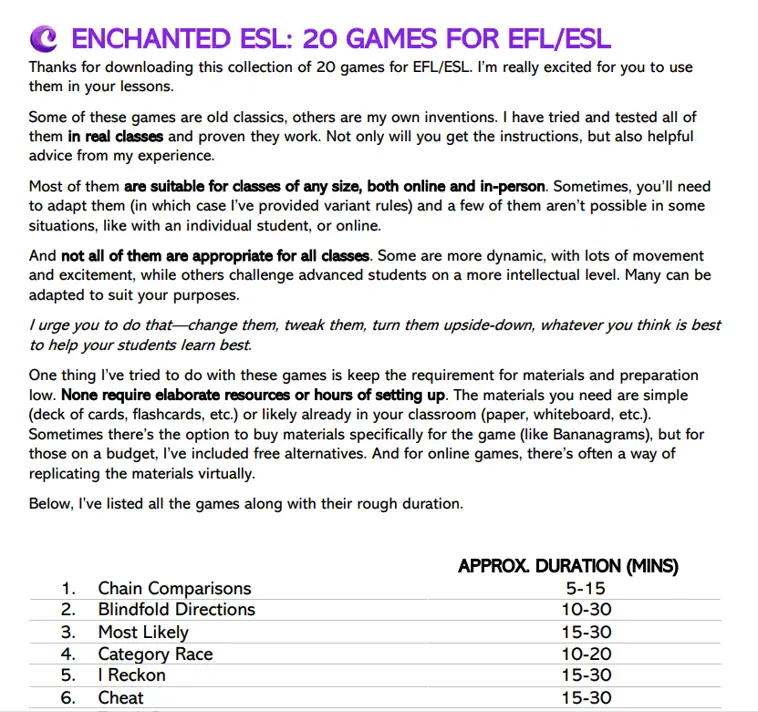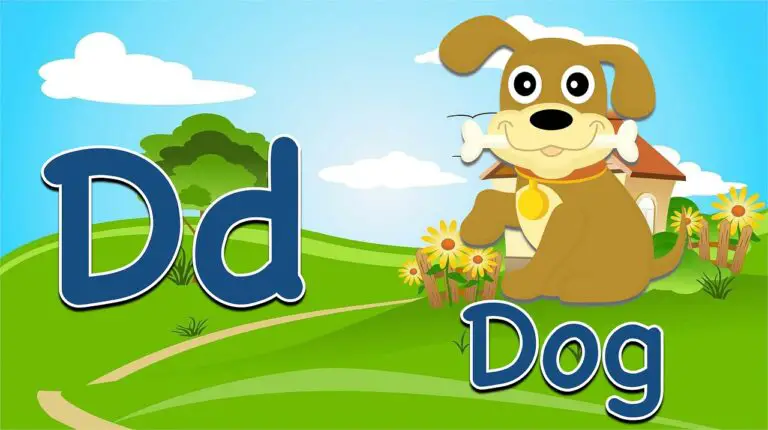Ever found yourself with five minutes to spare at the end of an EFL/ESL class? Despite planning a great lesson, you finished the work early and there’s not enough time to start something new. So what do you do? Play one of the five minute games on this list!

All good EFL/ESL teachers have a few quick games in their back pocket for those inescapable moments. The best teachers can improvise on the spot, too. If you can quickly connect the work you did in class with the fun of a quick review game at the end, you’re doing a great job.
The nine games here take 5 minutes or less to play. However, the first time you play them, it’ll take longer because you have to explain the rules and do a practice game.
Introduce them for the first time when you have plenty of time to spare. Then, when your students know how to play, you can bust them out when needed. Use them as starter activities or to round off a session.
So let’s get to it!
- What’s Changed?
- Just a Minute
- Chain Comparisons
- Countdown
- Hot Potato
- 21 (or 51 or 210)
- STOP
- Alphabet Race
- Who Am I? (or What Am I?)
Having a variety of quick, easy to set up games is a must. That’s why I recommend you get my free eBook of 20 ESL games. I reckon about half of them can be played in 5 minutes or less, and the other half are fantastic for other situations.
In the eBook I go into much more detail than in this article, with variants and guidance for all situations. You can get it for free right now by signing up to the Enchanted ESL Newsletter where you can also avail yourself of free game materials, role-play scenarios and lesson plans.
20 ESL Games by Enchanted ESL
- Detailed instructions & advice
- All ability levels
- In-person and online
- Individuals, small groups and large classes

1. What’s Changed?
What’s Changed? is a simple, engaging game which students of all ages can enjoy. It’s like spot the difference, but in real life.
English level: Beginner and Intermediate
Energy level: 5/5
Materials: None
How to play
One student (the identifier) is chosen. They quickly look at the room, then go out so they can’t see inside. Everyone else in the room rearranges a few things (can be obvious or subtle). The identifier comes back into the room and has 2 minutes to identify everything that has changed.
Depending on the level of your students, you should set your expectations for what the identifier should say. Beginners can just point and say words or phrases. You should challenge intermediate students to make full sentences and describe in as much detail as possible.
TIPS:
- Make sure everyone respects other people’s possessions, as well as the safety of others in the classroom. Ensure everything gets put back to normal at the end.
- To allow more students to have a turn, choose multiple identifiers (for example, 3 in a class of 30).
- Don’t change too many things. 5-10 is enough (per identifier) to challenge them in the time limit without being overwhelming.
2. Just A Minute
Just a Minute is a game from Radio 4 in the UK, which has been going for decades. It’s simple, but demanding. It works better with smaller groups (3-6) and isn’t great with big classes.
English level: Advanced (intermediate students can play if they’re confident)
Energy level: 3/5
Materials: Timer
How to play
One student begins as Speaker. Choose a relatively specific topic, for example, “American Sports”. Set a timer for 60 seconds. The Speaker starts talking.
During their speech, they should talk about the topic while not repeating any significant word, except for the words in the topic phrase.
In our example, they can repeat “American” and “Sport”. Words like “and”, “the”, and pronouns can be repeated.
At any point, other students can put their hand up to make a challenge. Pause the timer. The Challenger must identify which of the three following things the Speaker has done:
– Hesitation: Err, umm, long pauses, tripping over words.
– Repetition: Repeating a significant word not in the topic phrase.
– Deviation: Changing the topic (e.g. talking about American food).The teacher decides if the challenge is valid or not. If it is, the Challenger gets a point and becomes the new Speaker. They can repeat any words the previous Speaker(s) said. Start the timer again (don’t reset it, continue from the point you paused it).
If it’s not a valid challenge, the current Speaker gets 1 point and continues from where they left off.
Whoever is Speaker when the 60 seconds runs out earns 3 points.
Here’s a quick clip of the game in action. It’s played here by professional comedians, so the standards are high, and they’re very harsh on hesitation. With your students, I’d be a bit more generous with the time allowed to pause.
The first few times you play will be a bit messy. Students ake a while to get used to what is an acceptable challenge, and you as a teacher have to set the bar early. Here are some tips to help you do that.
TIPS:
- With hesitation, allow a short pause (1 second) between words and sentences.
- Repetition of words like: a, is, on, of, the, etc. should be allowed. I don’t consider them significant words.
- If students miss opportunities to challenge, let them know which ones they could have made, so they have a better idea next time.
- Speaking in an unnatural, robotic manner is allowed, as long as they aren’t hesitating.
- Challenging at the last second is allowed.
- This game can be stressful for some. If your group doesn’t like it, don’t force it on them.
3. Chain Comparisons
A fast-paced collaborative activity which you can repeat again and again, improving every time.
English level: Any (best with beginner/intermediate)
Energy level: 4/5
Materials: Timer
How to play
Organise students so they’re in a clear order (in a line or a circle). Choose a pair of complementing adjectives to compare (e.g. bigger/smaller). Set the timer for 2 minutes.
The first student says a word, for example: “banana”. The next student in order has to say something bigger than a banana (e.g. “planet”). The next student has to say something smaller than a planet, then the following student something bigger, and the pattern goes on.
While the game is progressing, keep score of how many words they’ve said and check the things they’re saying are bigger or smaller as appropriate. When the 2 minutes are up, the game ends and the class score is the number of words they said together.
TIPS:
- Keep track of the score, so when you repeat the game, they can try to beat it.
- If the class is big, extend the time limit so everyone gets at least one turn.
- If you have a small class with a low level, shorten the time limit.
- Encourage students to prepare answers before their turn, so they’re ready to say something. This avoids panicking in the moment.
- Join in the order yourself to introduce some new vocabulary on your turn.
- Change the words bigger/smaller to focus on different adjectives (e.g. cheaper/more expensive or slower/faster).
- Limit the words they can say to a category (e.g. animals) for more challenge.
4. Countdown
This one isn’t for beginners. And it’s also not great for young kids or those who struggle with letters and spelling. But it’s really fun to challenge those who can handle it.
You can play it for free in your web browser by going to this website.
English level: Intermediate and advanced
Energy level: 1/5
Materials: Paper & Pen, this website: https://incoherency.co.uk/countdown/practice/
How to play
Students have 30 seconds to make the longest word possible out of 9 given letters.
If you have time, let a student pick “consonant” or “vowel” to reveal the 9 random letters. (4-5 of each usually works best). Students should write down the 9 letters.
Start the countdown clock. While the music is playing, students try to make long words from the letters. They can only use each letter once.
At the end, each player says how many letters they got, and then reveals their answer (shortest word first). The winner is the person with the longest word!
Here’s a video in which I explain how it works. While you’re there, make sure to subscribe to the channel to get updated on all the new games and activities I share!
On the website, you can quickly set up a game by clicking “Random Fill”. This means you don’t have to spend time choosing consonants and vowels. You can also extend the time limit to 60 or 90 seconds, and even check whether some words are valid or not.
TIPS:
- Take part yourself. Challenge students to beat the English teacher!
- On the website, clicking the “Show Answers” button creates a list of all the possible words you could make with the letters.
- Bonus: Click on the “Conundrum” button to get an instant 9-letter anagram and see who (if anyone) can get the word first. Warning – this is hard!
5. Hot Potato
One of my favourite games of all time, Hot Potato is quick, exciting, and fantastic at reviewing vocabulary you just learned in class.
English level: Any
Energy level: 4/5
Materials: None
I like to play with an imaginary potato. You can play it with a ball or something else that gets thrown around, but I find this gets distracting and you lose time when it flies across the classroom.
How to play
Choose a vocab category (ideally something you learned recently). Everyone stands in a circle.
One person starts with the hot potato and mimes juggling it in their hands so they don’t get burned.
They have to keep the hot potato until they say a word in the category. Then they can pass it to the next in the circle. Play continues like this, with players passing the potato round and round, quickly coming up with new words.
If a player repeats a word somebody already said, or takes too long (5-10 seconds), they get BURNED. They lose a hand and have to juggle one-handed. If they get burned again, they only have their head to juggle with. Then, a final burning means they’re out of the game.
Play ends when only one player is left standing (or, more likely, you run out of time in the class).
TIPS:
- Take part yourself. You can introduce new vocabulary here, or reinforce difficult words.
- Apply the benefit of the doubt if you can’t remember whether a word has been repeated.
- Have fun standing up and miming the juggle. It’s a chance for students to be active and a little silly, as long as they respect the rules.
- Encourage students to think of a word when it’s not their turn.
- If you have a big class, consider running 2 or 3 smaller games so everyone’s engaged throughout.
The games on this list are a great place to start. But you can increase your collection and cover all bases with my free eBook of 20 ESL Games.
20 ESL Games by Enchanted ESL
- Detailed instructions & advice
- All ability levels
- In-person and online
- Individuals, small groups and large classes

6. 21 (or 51 or 210)
A fantastic game for quickly practicing numbers. I love how you can scale it to create more challenge and even add in extra rules for the quickest of classes. Don’t say the number 21!

English level: All levels (variations required for more advanced classes)
Energy level: 3/5
Materials: None
The basic game practices numbers from 1 to 21. But you can adapt the numbers to different ranges, like 30-51 or going up in tens from 10 to 210. As long as the range of numbers is 21, you can choose whatever you like.
How to play
Players sit/stand in a circle. The first player begins at 1 and can say one, two, or three numbers.
If they say a single number (e.g. “one”), the turn passes to the next person in a clockwise direction. If they say two numbers (“one, two”), the direction of play changes and the turn passes to the next person (now anticlockwise). If they say three numbers (“one, two, three”), the turn skips the next person in order and goes to the following.
Play goes on until someone can’t avoid saying the number “twenty-one” (or whichever number your game ends at). The player who says “twenty-one” has to do a “punishment”, e.g. talk for 30 seconds about a topic.
Suggested rules: If someone says two numbers (e.g. “five, six”), the next person can’t say two numbers (“seven, eight”) – they have to say one number or three numbers.
Extra fun rule: Each round, someone (could be the loser of the last round) creates a new rule. For example, instead of saying “five” you have to say a colour. Or, if you’re feeling really confident, the new rule could be to reverse the order of the numbers.
If you’re familiar with this game, the rules here should make sense. If not, and my brief description isn’t enough, here’s a link to the rules for the drinking game on Wikipedia.
TIPS:
- “Punishments” shouldn’t be hard. Keep them related to English and don’t make them do something they’re uncomfortable with. Talking about a topic for 30 seconds is good, as is saying the numbers in reverse order as fast as they can.
- Mistakes during the game, like talking out of turn, or saying an incorrect number, shouldn’t be a problem. If they’re becoming too frequent, think up a minor “punishment”.
- Get creative with added rules if you have adults who are on the ball. For example, on multiples of four, they have to stand up and do a dance and on multiples of five, they have to shout the number (see if they remember to do both on 20).
- Split big classes into smaller groups. The game works best with 5-8 players, as with more, it takes too long between turns to keep people interested.
7. STOP
Although STOP usually takes longer than 5 minutes, if your students are quick to set up, you can get one or two rounds in. It’s a great way to review vocab.
English level: Intermediate and Advanced
Energy level: 3/5
Materials: Writing equipment, timer (optional: random letter generator)
How to play
Divide students into 4-6 groups (students can play as individuals in small classes). Each group needs a piece of paper and a pencil.
Decide on 6 categories, e.g. sports, food, body parts, etc.
Select a letter. Either use a random letter generator, or by saying the alphabet quickly in your head and having one of your students shout STOP! Then you use the letter you’d reached in your head. Alternatively, pick a letter yourself.
Set the timer for 3 minutes. When you say “go”, the groups must write down a word that starts with the chosen letter for each category.
If a group has a word for every category, they can shout “STOP!”. Or, if the timer runs out, the teacher shouts “STOP!”
Either way, everyone must immediately stop writing. Groups read out what words they have in each category.
Award one point for each correct unique word (that no other groups wrote) and half a point for correct words which were repeated by another group. Incorrect words get zero points. Do this for all categories and add total the points – the team with the most points wins.
The scoring system forces students to think of unusual words. If the letter is “F” and the category is sports, writing “football” isn’t the best option since other students might have put the same. “Fencing” or “fishing” are more likely to get the full point.
TIPS:
- Before starting the timer, have each group write down the category headings. If you really want to speed things up, have a few sheets prepared with category headings already written.
- If the letter is something like X or Q, choose a new one. With lower-level groups, you can exclude some other letters, like J, Z and W, if you think they’ll be too hard.
- For advanced students, challenge them with subcategories. Instead of “food”, choose “dairy products”.
8. Alphabet Race
A fantastic game you can play in a couple of minutes at the start or end of class. It’s great for learning the alphabet, but can be adapted to give more of a challenge, too.
English level: Beginner (Intermediate variations can be played)
Energy level: 4/5
Materials: Stopwatch
How to play
Students should get into a line or circle so there’s a clear order. Start the stopwatch. When you do, the first student in the order says “A”, the next “B”, then “C” etc. Keep going until someone makes a mistake (start again), or you get to Z – stop the stopwatch.

In the few seconds before playing the game, it might be worth reviewing some of the trickier letters (G, J, Q, W, etc.) so your students have a better chance of getting to the end.
TIPS:
- When someone makes a mistake, instead of starting from the beginning of the order, start with the student after the one who got it wrong.
- Keep track of how long it takes to get from A-Z and try to improve each time you play.
- Avoid blaming or criticising those who make mistakes, instead encourage them. Get the others students to follow your lead.
- A more advanced variation is to say a word beginning with the letter instead of the letter itself.
- Make it even more difficult by saying the alphabet backwards.
9. Who Am I? (or What Am I?)
A super simple, adaptable game which every teacher should know.
English level: All levels
Energy level: 2/5
Materials: None
How to play
Choose a category of vocabulary – sports, animals, jobs, etc.
One student comes to the front. Secretly show them a word in the chosen category. Let’s say, in this case the category is jobs, and they’re a pilot.
The other students ask yes-or-no questions to figure out who/what the student is.
If a student makes a correct guess “are you a pilot?”, it’s their turn to come to the front and play.
What’s great about this game is you can focus on making questions while also practicing vocab.
TIPS:
- With advanced students, use more challenging vocab, and perhaps don’t even reveal what the category is.
- With beginner students, write some scaffolded questions on the board to help them.
- Encourage students not to shoot in the dark by enforcing the rule that if they guess wrong, they can’t guess again.
Conclusion
Five minutes in an EFL/ESL class is nothing. While you think you can get in some great learning, it’s often the case that the time passes before you can even start a new activity.
That’s why these games are great. When you’ve established how to play, students can get involved automatically with very little setup time. Whether you use them at the end of class, or as warmups, there’s something for everyone.
And there’s something for everyone in my free ebook of 20 EFL/ESL games. In the ebook, you get my insights on how to adapt games to different ages, abilities and class formats, with many of the games playable in 5 minutes or less. Get it, and a whole bunch of other resources, for free by signing up to the Enchanted ESL Newsletter.
20 ESL Games by Enchanted ESL
- Detailed instructions & advice
- All ability levels
- In-person and online
- Individuals, small groups and large classes

If you’re looking for more games and activities, check out my other lists:
9 EFL/ESL Speaking Games & Activities Perfect for Beginners
9 EFL/ESL Games & Activities for Intermediate Learners
9 EFL/ESL Games and Activities for Advanced Learners
9 High Energy EFL/ESL Games for Boosting Vocabulary
9 Engaging Homework Ideas for EFL/ESL: No worksheets!
9 Exciting EFL/ESL Activities for Writing & Spelling
9 Fun EFL/ESL Games & Ideas With Standard Playing Cards
9 EFL/ESL Games With No Materials or Preparation Needed
9 EFL/ESL 5 Minute Games Every Teacher Needs to Know
9 Superb EFL/ESL Games & Activities Using Just Pen & Paper
9 Classy EFL/ESL Games & Activities for Adults (+ tips)
9 Confidence-Boosting EFL/ESL Speaking Games for All Levels
9 Exciting Flashcard Games for EFL/ESL Classes







